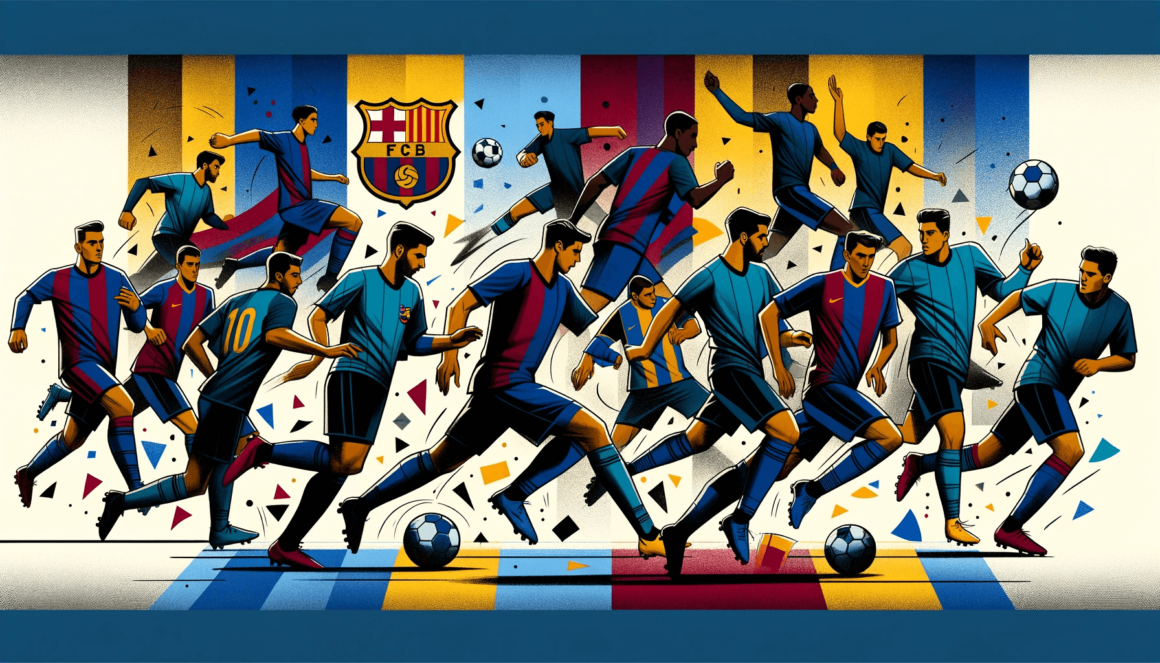Tiki-Taka: Barcelona’s Version of Total Football
The Spanish way of playing football has always caught the eye of many admirers. The style is fluid, possession-based, and relies on short passing to create chances. This type of football is often referred to as tiki-taka and was made popular by Barcelona back in the late 2000s. In this article, we’ll take a look at what this style is, how it works, and why teams are still using it today.
Overview

This style of play was made famous by Barcelona’s team when Pep Guardiola was manager. It’s based on keeping possession of the ball, controlling the game, and waiting patiently for a good position to score. Although Pep didn’t like the name very much, Barcelona and tiki-taka were synonymous for a time.
However, it was the success of the Dutch national team and its “Total Football” in the 1970s that started everything off. The team revolutionized the modern game of soccer with an approach that focused on preparing to attack from all possible angles and players switching positions, making the game appear more fluid, creative, and beautiful to watch.
Johan Cruyff carried on this attacking soccer philosophy and further developed it as Barcelona’s manager in the ‘90s. Indeed, Barcelona’s style of play during this era was the basis for its dominance when Guardiola was still a player.
How Does This Tactic Work?
To successfully employ this tactic, a team must be able to maintain possession of the ball for long periods of time. This requires each player on the team to be comfortable with the ball at their feet and have the ability to make quick, decisive passes. The focus is on short passes between players rather than long balls over the top of defenders.
Keeping the ball in your possession leaves your opponent with less time to create chances and score. However, doing so requires a team that is well prepared and has excellent stamina and concentration. Before we take a look at which famous teams use tiki-taka soccer tactics, we’ll go over the development of a modern soccer strategy that led to the success of Pep Guardiola’s Barcelona.
Beginnings: Total Football
Dutch soccer experts were looking to develop tactics based on a more open and attacking style of play. This soccer philosophy originated with Rinus Michels at AFC Ajax from Amsterdam, and from there, it was quickly adopted by the national team.
Total Football called for players who could switch positions as the game dictated and play different roles on the pitch. Nobody was better at this than the young Johan Cruyff.
Originally a center forward, Cruyff could mercurially change from position to position, preying on opposition weaknesses and looking to score from counter-attacks. He was encouraged to roam the pitch freely and would pose an ongoing threat to opposition defenders. The team was developing a fluid, attacking style that would in time become a trademark of tiki-taka soccer.
The Dutch national team won against some of the best teams of the era, like Brazil and Argentina. This was also the era of the Italian style of defensive play popularly known as “catenaccio” or “door bolt.” A tactic based on highly defensive positioning, its aim was to cut short all the opposition’s attempts at offense, and the Italian team was remarkably good at it. Italian defensive play became infamous during this time, but it has helped the country snatch four World Cups, the only country to do so besides Germany.
The Dutch team finally broke the catenaccio tactic with its ultra-attacking strategy. That was the seal of approval Total Football needed.
Johan Cruyff went on to further develop the attacking soccer philosophy he was involved in creating as a player. He became one of the most prominent managers of the 1990s, and during his tenure with the Catalonian team, he continued the evolution of Total Football that would become tiki-taka soccer at Barcelona.
Total Football the Barcelona Way
Barcelona’s ties with Dutch soccer have been strong since the late ‘80s, when Johan Cruyff became the manager of the Camp Nou team. The new coach brought with him an ensemble of hand-picked top players from Holland, but more importantly, he taught the philosophy of Total Football to the Catalonians. With the results proving positive for the first team, Cruyff’s system was implemented in La Masia, Barcelona’s youth academy.
The talent-packed attacking style employed by Barcelona’s Dream Team led to its success in the ‘90s, when a squad of Spanish players mixed with international superstars claimed four national titles in a row.
In Barcelona’s Dream Team, alongside soccer idols like Laudrup, Romario, and Stoichkov, there was also the young Pep Guardiola, playing as the team’s pivot, a deep midfield position from which he would masterfully control the pace of the game. The seeds for the tiki-taka formation were laid.
Before becoming the head coach for the Catalonian team, Pep Guardiola would remark: “Cruyff built the cathedral, and our job is to maintain and renovate it.”
Pep’s Soccer Philosophy
Pep started as a Barcelona youth, joining the club at 13 and becoming part of the senior team at 20. He played the pivot in Cruyff’s team: a midfielder who connected all the dots and took command of the pitch with the captain’s band around his arm.
As a manager, Pep made the tiki-taka style of play famous when he led Barcelona to an unprecedented period of success between 2008 and 2012. But the roots of this style can be traced back to La Masia, Barcelona’s youth academy.
La Masia has produced some of the world’s best soccer players, including Lionel Messi, Xavi Hernandez, Andres Iniesta, Sergio Busquets, and many more. These players were all brought up in the Barcelona academy with the same principles of keeping the ball and playing possession-based soccer.
Ironically, Pep disregarded the name tiki-taka, as he didn’t think it did the team justice; the “touch-touch” style that everybody saw was just the tip of the iceberg. For sure, Barcelona did play with a style that was beautiful to watch, but its success came from always looking to advance the game towards the opponent’s goal. They would keep the ball in possession as long as it took to tilt the defense to one side of the pitch and open up space for scoring chances.
Pep’s philosophy was that as long as you keep the ball, there is no real threat to the defense, so he would often play without true full-backs in defense and would replace them with defensive midfielders like Mascherano or Busquets, who could stay on the ball better.
After Barcelona, Guardiola managed Bayern Munich and Manchester City, winning domestic and European titles along the way. Although the legendary success of the Barcelona team will be hard to surpass, Pep has definitely proven that his strategy with Barca wasn’t all flair and no substance.
Spain’s National Team
While tiki-taka has been incredibly successful at the club level, it has not always fared so well internationally. Spain’s World Cup triumph in 2010 was built on the back of a rock-solid defense, as the team conceded only two goals in seven matches. However, the lack of a cutting edge in attack led to Spain being knocked out of the 2014 World Cup in the group stage, and the proud soccer nation could not retain its European Championship title in 2016.
During this era, the Spanish team played a fluid, attacking game of soccer, much like the style of tiki-taka at Barcelona. At times, it looked as if Barca’s midfield was simply transported to the national side and given different jerseys to wear: Xavi, Iniesta, Fabregas, and Busquets all represented both sides. As their careers were coming to an end, Spain had to find new solutions if the national team was to start winning again.
Is the Style Still Relevant?
Tiki-taka requires high levels of fitness, as all players have to do a lot of running and pressing off the ball. This isn’t an easy tactic to emulate, but managers and teams have, with some success, tried to copy Guardiola’s approach over the years.
Luis Enrique tried to implement soccer in the tiki-taka style when coaching AS Roma in 2011, and he was called to Barcelona in 2014 with hopes of ushering in a new golden era for the Catalans. His experience and commitment to this soccer style make him a fit candidate to oversee the Spanish national team, which he now does.
Brendan Rodgers is another high-profile manager who has tried to emulate Pep’s vision of the game. He was the head coach at Swansea City, where he implemented the strategy with great results, leading the underdogs to take points against Chelsea, Tottenham, and Liverpool, and steer well clear of the relegation zone.
He later came to Liverpool, where he would stay for four years, improving the standings and the goal-scoring form of the club each year and preparing the squad for the successes that were soon to come.
The tiki-taka tactic worked so well at Barcelona with the incredible talent of Xavi, Iniesta, and Messi behind the ball. But without that amount of talent in the midfield, it has been hard for teams to cope with a new pressing style called ”gegenpressing” which creates a more physical game. Jurgen Klopp made this style famous with Borussia Dortmund, and now many German, Dutch, and English teams are adapting to it.
Final Thoughts
The tiki-taka soccer tactic became prominent under Pep Guardiola, who led Barcelona to unprecedented success between 2008 and 2012. The key principles of its tactics are simple: keep possession of the ball for as long as possible and make short passes to create chances.
To a certain point, the tactic is still relevant today. European soccer teams like Swansea, Roma, and Liverpool have all employed it over the past decade or so. Discipline, creativity, and stamina are required to pull tiki-taka off, but when all players are committed to the system, it can give clubs a fighting chance against much stronger rivals.
FAQ
What is tiki-taka?
Tiki-taka is a style of soccer that originated in Spain and was made famous by the Spanish national team and FC Barcelona. The word “tiki” comes from the sound of the ball being passed back and forth between players, while “taka” means “touch.” This style is about keeping possession of the ball and making short, quick passes to create chances for goals.
Where did tiki-taka originate?
The origins of this soccer tactic can be traced back to the 1970s, when Johan Cruyff and his Dutch side popularized a style of play known as Total Football. This system relied on every player being comfortable on the ball and able to play multiple positions, allowing the team to easily switch between attacking and defending. While Total Football didn’t last long at the highest level, its concepts were adopted by Barcelona’s legendary La Masia academy in the 1990s.
 BC.Game
BC.Game  7Bit
7Bit  Ducky Luck
Ducky Luck  Red Dog
Red Dog